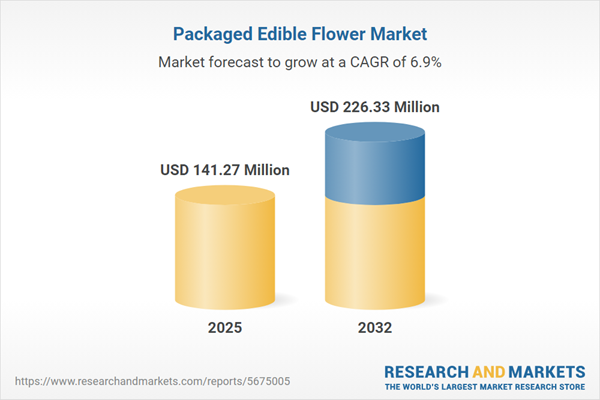Speak directly to the analyst to clarify any post sales queries you may have.
Senior decision-makers in food, beverage, and wellness sectors are increasingly turning to the packaged edible flower market as a lever for innovation, strategic growth, and enhanced differentiation. As industry expectations shift toward transparency and natural sourcing, leaders are recalibrating strategies to harness the sector's potential for portfolio improvement and supply chain flexibility.
Market Snapshot: Packaged Edible Flower Market
The packaged edible flower market began 2024 at USD 132.23 million and is projected to grow to USD 141.27 million by 2025, reflecting a 6.94% CAGR. Forecasts anticipate a rise to USD 226.33 million by 2032.
Expansion is fueled by changing culinary approaches, botanicals' growing role in wellness products, and an increasingly transparent global supply chain. Industry leaders are investing in robust supply infrastructure to meet evolving regulations and consumer demands for clean-label products. Ongoing attention to tariffs and compliance is driving sustainable growth approaches in this dynamic market environment.Scope & Segmentation of the Packaged Edible Flower Market
This report delivers tailored insights to support C-suite strategies encompassing investment evaluation, market entry, and portfolio optimization. Segmentation analysis enables senior executives to thoroughly assess operational and strategic opportunities within the packaged edible flower market. The following elements are covered:
- Distribution Channels: Analysis of performance and procurement cycles in food service, specialty retail, supermarkets, ecommerce, and direct sales, supporting access and growth strategies.
- Flower Types: Profiling of chamomile, hibiscus, lavender, marigold, and rose with a focus on adaptability in culinary and wellness product lines.
- Forms: Assessment of candied, dried, freeze-dried, fresh, and preserved offerings to gauge product stability and suitability for diverse application pipelines.
- Applications: Evaluation of integration in bakery, confectionery, specialty foods, beverages, and nutritional supplements, illustrating potential for category diversification.
- End Uses: Identification of developments across cosmetics, food manufacturing, personal care, and pharmaceutical segments, highlighting new expansion paths.
- Types: Tracking the market impact of conventional versus organic sourcing to inform procurement and address shifting buyer preferences.
- Purpose: Differentiation between decorative and functional product attributes, aiding in premium positioning and brand targeting.
- Regional Coverage: Mapping market dynamics across North America, South America, Europe, Middle East and Africa, and Asia-Pacific, facilitating adaptation to local regulatory requirements and consumer preferences.
- Key Companies Profiled: Benchmarking established players including Dole Food Company, Greenyard NV, Florette Group SA, Fresh Origins, Gourmet Sweet Botanicals, Les Fleurs Comestibles SAS, Delicious Blooms BV, EatFlowers Limited, Petal Fresh Farms, and Flowers by Suda Inc. for competitive landscape clarity.
Key Takeaways & Strategic Insights
- Expansion into cosmetics and pharmaceuticals is opening opportunities to serve new customer segments and broaden revenue streams.
- Advancement of digital supply chain solutions, such as precision agriculture and enhanced traceability, is supporting operational efficiency and strengthening compliance frameworks.
- Adoption of emerging preservation and minimal-processing techniques is enabling product innovation and helping brands meet clean-label and transparency objectives.
- Monitoring of regulatory developments and technology trends is necessary to sustain agility and reinforce risk mitigation strategies.
- Innovation in beverage and nutraceutical segments is leveraging established distribution networks, allowing for faster category and geographic penetration.
- Strengthened collaboration within supply chains is improving market responsiveness and enabling scalability in line with sustainability goals.
Tariff Impact: Navigating U.S. Policy Changes
Recent U.S. tariff revisions have begun influencing sourcing and procurement within the packaged edible flower market. Senior executives are responding by prioritizing domestic supplier relationships, enabling cost stabilization, reducing exposure to supply chain interruptions, and simplifying compliance with evolving regulations.
Methodology & Data Sources
This analysis synthesizes executive interviews, trade association data, regulatory documentation, customs records, and expert panel contributions. Scenario modeling and granular market segmentation underpin actionable recommendations for leadership decision-making.
Why This Report Matters
- Enables robust investment and market entry planning through segmentation intelligence and supplier benchmarking, supporting evidence-based decision-making.
- Provides strategic guidance on digital transformation initiatives and regulatory compliance aligned to the unique requirements of senior market leaders.
- Equips executives in nutrition, food, and wellness industries with actionable insights for innovation and sustainable partnership formation throughout the value chain.
Conclusion
Strategically adopting regulatory and consumer trends positions organizations for resilience and growth within the packaged edible flower industry. Technology adoption and alliance-building further reinforce sustainable market leadership in this evolving space.
Additional Product Information:
- Purchase of this report includes 1 year online access with quarterly updates.
- This report can be updated on request. Please contact our Customer Experience team using the Ask a Question widget on our website.
Table of Contents
3. Executive Summary
4. Market Overview
7. Cumulative Impact of Artificial Intelligence 2025
Companies Mentioned
The companies profiled in this Packaged Edible Flower market report include:- Dole Food Company, Inc.
- Greenyard NV
- Florette Group SA
- Fresh Origins, Inc.
- Gourmet Sweet Botanicals, LLC
- Les Fleurs Comestibles SAS
- Delicious Blooms BV
- EatFlowers Limited
- Petal Fresh Farms, Inc.
- Flowers by Suda Inc.
Table Information
| Report Attribute | Details |
|---|---|
| No. of Pages | 185 |
| Published | November 2025 |
| Forecast Period | 2025 - 2032 |
| Estimated Market Value ( USD | $ 141.27 Million |
| Forecasted Market Value ( USD | $ 226.33 Million |
| Compound Annual Growth Rate | 6.9% |
| Regions Covered | Global |
| No. of Companies Mentioned | 11 |









